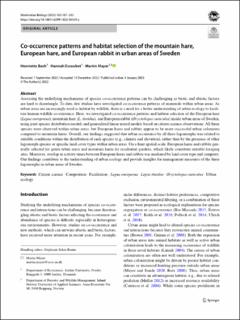Co-occurrence patterns and habitat selection of the mountain hare, European hare, and European rabbit in urban areas of Sweden
Peer reviewed, Journal article
Published version

View/
Date
2023Metadata
Show full item recordCollections
Abstract
Assessing the underlying mechanisms of species co-occurrence patterns can be challenging as biotic and abiotic factors are hard to disentangle. To date, few studies have investigated co-occurrence patterns of mammals within urban areas. As urban areas are increasingly used as habitat by wildlife, there is a need for a better understanding of urban ecology to facilitate human-wildlife co-existence. Here, we investigated co-occurrence patterns and habitat selection of the European hare (Lepus europaeus), mountain hare (L. timidus), and European rabbit (Oryctolagus cuniculus) inside urban areas of Sweden, using joint species distribution models and generalized linear mixed models based on citizen science observations. All three species were observed within urban areas, but European hares and rabbits appear to be more successful urban colonizers compared to mountain hares. Overall, our findings suggested that urban occurrence by all three lagomorphs was related to suitable conditions within the distribution of each species (e.g., climate and elevation), rather than by the presence of other lagomorph species or specific land cover types within urban areas. On a finer spatial scale, European hares and rabbits generally selected for green urban areas and mountain hares for residential gardens, which likely constitute suitable foraging sites. Moreover, overlap in activity times between European hares and rabbits was mediated by land cover type and sympatry. Our findings contribute to the understanding of urban ecology and provide insights for management measures of the three lagomorphs in urban areas of Sweden.
